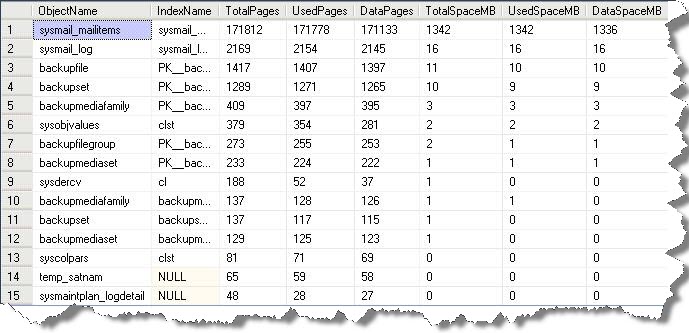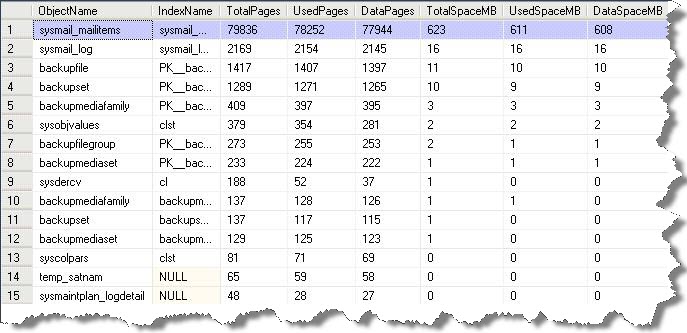This should be the common issue faced by many of us where the database mail is used to send bulk mails on a regular basis. We have a database server which is specifically used for sending weekly newsletters to all the subscribed users. The number of subscriptions increased over a period of time and so as the number of newsletters. One day the disk drive, holding the system databases, started alerting for the low disk space. On investigation, I found that the msdb database has grown to 7 GB in size!
As we know that msdb maintains various types of history information like backup history, jobs history, sent mails and attachments history etc. Now the question is to find out the table(s) holding the largest data. I have found the following query from the Net which helped me to find out the name of the tables in descending order of space consumed on the disk.
(As the above issue had already been fixed, I can not show you the 7 GB grown msdb. For this demo I am running this query on a server having 1.5 GB grown msdb)
use msdb go sp_helpdb msdb

--Query 1 - Checking the size of tables in a database
select
object_name(i.object_id) as ObjectName,
i.[name] as IndexName,
sum(a.total_pages) as TotalPages,
sum(a.used_pages) as UsedPages,
sum(a.data_pages) as DataPages,
(sum(a.total_pages) * 8) / 1024 as TotalSpaceMB,
(sum(a.used_pages) * 8) / 1024 as UsedSpaceMB,
(sum(a.data_pages) * 8) / 1024 as DataSpaceMB
from
sys.indexes i
inner join sys.partitions p
on i.object_id = p.object_id and i.index_id = p.index_id
inner join sys.allocation_units a
on p.partition_id = a.container_id
group by
i.object_id,
i.index_id,
i.[name]
order by
sum(a.total_pages) desc,
object_name(i.object_id)
go

We can see that sysmail_mailitems table is occupying most of the space on the disk, around 1.3 GB spanning across 171812 pages. This table stores the database mail messages which are sent, unsent, retrying, and failed. Microsoft recommends maintaining this table by periodically deleting the messages based on the organizations document retention program. The sysmail_delete_mailitems_sp procedurelocatedin the msdb database permanently deletes e-mail messages from this table. The syntax of the procedure is shown below
sysmail_delete_mailitems_sp [ [ @sent_before = ] 'sent_before' ] [ , [ @sent_status = ] 'sent_status' ]
The date option allows deleting e-mails before the specified date and the status option allows deleting e-mails of a particular type i.e. sent, unsent, retrying, and failed.
As deleting a huge amount of records in one shot takes a good amount of time we can purge the data in small batches. The below query will identify since when the data is lying in the table. This is especially useful when the data is piled up over a long period of time.
--Query 2 - Checking the records by year, month
select
datepart(yy,sent_date) [Year],
datepart(mm,sent_date) [Month],
count(*) 'NoOfRows'
from
sysmail_mailitems
group by
datepart(yy,sent_date),
datepart(mm,sent_date)
order by
1,2

The table has data for two months. Let’s keep the data for March and deleted the February data. The following query will do the job,
--Query 3 – Purging the data before 1st March 2011 DECLARE @DelDate nvarchar(20) ; SET @DelDate = '03/01/2011' EXECUTE msdb.dbo.sysmail_delete_mailitems_sp @sent_before = @DelDate;

Now run the Query 1 and check the output. The total table space which was 1372 MB has come down to 623 MB and also the Total Pages from 171812 to 79836.

Let’s check the database size using,
sp_helpdb msdb

No luck???!!! In fact the log size has increased. Don’t worry, now we need to truncate the log and shrink the database so that the free space will be release to the operating system. Run the following code and recheck the database size.
--Query 4 - Truncate the log and shrink the database
checkpoint
backup log msdb with truncate_only
dbcc shrinkdatabase ('msdb')
sp_helpdb msdb

It worked… 🙂
Regards
Amit Karkhanis
Like us on FaceBook | Follow us on Twitter
Join the fastest growing SQL Server group on FaceBook
